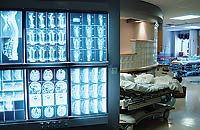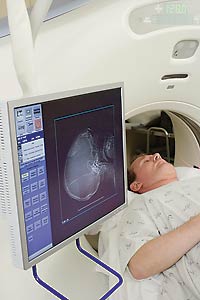|
|
Depression Can Mean Many Things
by Stephen Proskauer MD
|
 If doctors did appendectomies every time a patient complained of stomachache, what kind of medicine would that be? Careful diagnosis must guide choice of treatment. The same goes for depression. When patients complain that they feel down, guilty, bad about themselves, can't concentrate, lose appetite and weight, don't sleep well, often cry and wish they were dead, and sometimes become actively suicidal, doctors usually diagnose Major Depressive Disorder (MDD) and prescribe antidepressants. Often that helps, but sometimes it just covers up a deeper problem or makes things worse, because there are many other causes of depressive symptoms besides MDD. If doctors did appendectomies every time a patient complained of stomachache, what kind of medicine would that be? Careful diagnosis must guide choice of treatment. The same goes for depression. When patients complain that they feel down, guilty, bad about themselves, can't concentrate, lose appetite and weight, don't sleep well, often cry and wish they were dead, and sometimes become actively suicidal, doctors usually diagnose Major Depressive Disorder (MDD) and prescribe antidepressants. Often that helps, but sometimes it just covers up a deeper problem or makes things worse, because there are many other causes of depressive symptoms besides MDD.
What if depression is not constant but interrupted by bursts of excitement, elation or irritability? Then Bipolar Disorder would be a more likely diagnosis and antidepressants might only set off a manic attack or help briefly or not at all. A mood stabilizing drug is indicated instead. Even ordinary MDD symptoms might suggest an underlying bipolar problem if depression or irritability began in childhood or adolescence, sometimes leading to self-medication with alcohol or street drugs.
 Research shows that bipolar patients wait an average of ten years after first seeing a doctor before receiving the correct diagnosis. Many doctors assume a depressed patient has MDD unless they are obviously manic. I once had a severely depressed patient who had been misdiagnosed as MDD for 25 years, even at a university mood disorder clinic, without ever getting the correct diagnosis or effective therapy! By the time I met her, she was ready to give up all hope and kill herself, as much due to the years of treatment failure as because of the depression itself. She responded well to mood stabilizers and could finally lead a normal life. All it took was to explore the question “What is causing the depression?” instead of assuming it is MDD. Research shows that bipolar patients wait an average of ten years after first seeing a doctor before receiving the correct diagnosis. Many doctors assume a depressed patient has MDD unless they are obviously manic. I once had a severely depressed patient who had been misdiagnosed as MDD for 25 years, even at a university mood disorder clinic, without ever getting the correct diagnosis or effective therapy! By the time I met her, she was ready to give up all hope and kill herself, as much due to the years of treatment failure as because of the depression itself. She responded well to mood stabilizers and could finally lead a normal life. All it took was to explore the question “What is causing the depression?” instead of assuming it is MDD.
Sometimes prolonged grieving or despair about family problems can lead to a condition resembling MDD, but if the patient receives pills without psychotherapy, the problem gets masked rather than resolved. And when depression is the first sign of dementia or cancer or some other medical problem, then antidepressants just cover it up and delay treatment until other symptoms appear.
Like stomachaches, depressive symptoms may indicate a variety of possible problems requiring different treatments. Next month we will examine various types of anxiety.
|
Moab Regional Hospital Radiology Department |
At Moab Regional Hospital, our Imaging and Radiology Department provides you with a complete range of diagnostic and treatment services. Using state-of-the-art equipment, our skilled team provides you with caring, safe, and accurate imaging services that are fully coordinated with your medical care.
These services can help your medical team to:
- Diagnose the cause of your symptoms
- Diagnose a broken bone
- Monitor the health of a baby before birth
- Observe a treatment you are receiving for a disease or condition and monitor the progress your body is making to this treatment
- Screen for illnesses like breast cancer, colon cancer, or heart disease
|
Each of the imaging technologies we work with has a team of trained professionals running your diagnostic tests and screenings. We take pride in the skills of our team members and their ability to use this advanced equipment to offer our patients the highest level of care in an efficient matter of time. All of our imaging is read by a Board Certified Radiologist via teleradiology services provide through Utah Imaging Associates to ensure the highest level of accuracy.
 Here is an overview of the imaging technologies available at MRH: Here is an overview of the imaging technologies available at MRH:
X-Rays and Fluoroscopy
X-Rays are an important part of our imaging department and are commonly used to non-invasively view broken bones and other medical conditions. Fluoroscopy is used to take streaming real-time images by x-ray and combines those images to create a kind of “x-ray movie”.
CT or CAT
Computed Tomography or Computed Axial Tomography is an x-ray procedure that combines many x-ray images with the aid of a computer to generate cross-sectional views and, if needed, three-dimensional images of the internal organs and structures of the body. In just seconds, this advanced technology can make a complete scan of your entire body - or produce detailed views of a targeted area.
MRI
 Magnetic Resonance Imaging is a painless and safe diagnostic procedure that uses a powerful magnet and radio waves to produce detailed images of the body’s organs and structures, without the use of x-rays or other radiation. Magnetic Resonance Imaging is a painless and safe diagnostic procedure that uses a powerful magnet and radio waves to produce detailed images of the body’s organs and structures, without the use of x-rays or other radiation.
3D Digital Mammography
Mammography is a specific type of imaging that uses a low-dose x-ray system to examine breasts and is the primary means of the early detection of breast cancer. Computer-aided detection (CAD) systems use an image obtained from a digitally acquired mammogram. We also offer 3D digital mammography, which improves the quality of the images, improves breast cancer detection, and reduces the need for follow-up imaging.
Ultrasound
Ultrasound uses high-frequency sound waves to produce images inside of the body that can be viewed on a monitor. It is a safe and painless way to view internal organs without radiation and is often used to monitor the health and development of a baby before birth.
Bone Desitometry
Bone Density testing is a tool for classifying bone mass as normal, osteopenia or osteoporosis. This procedure is non-invasive and may be ordered by your doctor to determine if you have osteoporosis or low bone mass.
|
| Well Being-The power of a personal Yoga practice |
Good morning: I am in a half sleep at the ripe hour of 4am. A glass of water, cold shower, candles lit. I roll my yoga mat out, sit and begin to slow my breath. I move my body to that same rhythm, at times losing my focus or the stability of my breath. I navigate poses, seated to standing and back down again. 2 hours pass, seated once again with a clear focus in my mind and I sit in quiet-stillness, ready to begin my day with the outside world.
Is this what your personal yoga practice looks like? No? Me neither. This is a romantic (yes- possible) version of what some of us think a personal yoga practice is supposed to look like.
Now add a full-time job (maybe more than one job), children, pets, partners, home repairs, physical injury/surgeries. What may a personal yoga practice look like for those of us with busy lives?
***It’s 6am, you have 15 minutes before the family awakes…how do you spend it? 5 minutes stretching, 3 minutes focused on the rhythm of your breath, 2 minutes reading a poem or journaling…5 minutes enjoying your coffee in silence.
***It’s lunch time, you get a one-hour break…before leaving the office: sit at the edge of your chair, plant your feet and move your spine. Spend 5 minutes resting on the floor with legs up your chair, slow your breath, feel the sensations in your body.
***Now you are home with groceries, kids…it’s evening go time! Kids semi settled in, practice body awareness/posture while preparing dinner. 3 minutes in the bathroom quieting your breath, feeling the body relax from the toes up to the face.
***Before bed, recall one pose you liked in a yoga class, be curious-explore the pose for a few minutes.
A personal practice is as unique as you are. It takes discipline whether it’s a focused 3 minutes or two hours. The amazing thing about yoga, is it not only assists the physical body through stretching and stabilizing. You can also practice yoga and never once do any poses, the focus of the practice is breath work, mindfulness and meditation. Yoga is a practice that brings you to yourself, a union so to speak.
Many of us spend much of our day thinking and stressing. By developing discipline in our mind and our actions, we build upon that design and begin to develop control and focus. As we consciously begin to calm our mind and body, we reduce stress, develop clarity and we get to have this incredible experience as if we just gained time/space and create Well-Being!
Want to develop a 3, 5, 10 minute (or more) daily personal yoga practice?
Join Star Kolb, Kristi Paul, and Moab Yoga for a 30 day Yoga and Well Being Invitation. Daily guidance with accessible breath & meditation practices. Each week will build on the prior, slowly building the length of time.
February 1-March 1, 2020. Free, registration required. www.moabyoga.com
Do you want to invite more challenge into this invitation, attend 16 Moab Yoga classes within those 30 days and receive a free yoga workshop co-taught my Star Kolb & Kristi Paul: Saturday March 7, 2:30-5pm.
|
Looking for Better Health and Longer Life?
by Dr. Ray Andrew |
About this time of year, most Americans are either just gearing up to start their health-related New Year’s Resolutions, or have already given up on them! For many of us, those resolutions include something related to weight. But we don’t limit our efforts to January. In fact, the average American surveyed attempts FIVE diets per year. This is not surprising considering that 40% of U.S. adults are obese and an additional 38% are overweight but not yet obese.
As a result of this epidemic, people are trying every diet they can find. Each one that comes along claims to be the ultimate effective once-and-for-all solution to the battle of the bulge…until the next revolutionary diet comes along. Many give up on the diet industry when they discover that each miracle diet fails them and is replaced by yet another fad in a year or two.
In reality, no single diet is perfect for everyone. In fact, studies have demonstrated that there isn’t even a perfect diet for any single person. Rather, diet variation is key to optimal health. For example, the populations of good bacteria (microbiome) in your gut—which play critical roles in your body—depend on you varying what you eat, how much you eat, and when you eat. We’ve all been taught that one of the best things we can do is eat salad every day. Not so. Obviously a salad is preferable to a Big Gulp, but your gut microbiome doesn’t want to feed on the same salad day after day. Change it up! Besides, if you don’t, you’ll get bored of it anyway.
With that said, regardless of your favorite diet, there is something you can do to make it even better. For thousands of years, all of the world’s major religions have taught and encouraged the practice of periodic fasting. For some, it is one day every month. For others, a certain number of days in a row each year. For some, it’s a dry fast. For others, water is permitted. As a rule, religions promote fasting for spiritual reasons, including subduing the body to the spirit and humbling oneself before God. 
In the last several years, however, scientists have discovered that fasting has powerful health benefits that nearly everyone can enjoy, regardless of religion. Depending on your individual circumstances, water-only fasting for 12-14 hours a day (aka intermittent fasting), or even water fasting for five days in a row, can have profound health benefits. Fasting is so powerful that, when timed just right, it makes chemotherapy significantly more effective against cancer and dramatically less toxic to healthy cells, causing fewer side effects. Of course, be sure to speak with your functional medicine doctor before undertaking any of these fasting approaches. You need to make sure it is right for your needs, and that it’s done properly.
But you don’t have to have cancer to benefit from fasting. Imagine losing fat—not muscle—and reducing blood sugar, blood pressure, cholesterol, and inflammation. Imagine not needing insulin or drugs for type 2 diabetes. Imagine increasing stem cell activity to repair damaged tissues. Imagine no longer needing arthritis pills for all those aches and pains. What would it be like to have more energy and a clearer mind?
One of the exciting benefits of five-day fasting is called autophagy (“awe-TAW-fa-gee”). This is the process of breaking down damaged cell components and actually reusing them. It’s the ultimate recycling program! Autophagy reduces cancer, autoimmune disease, cellular aging, and much more.
When I first learned about multi-day fasting at the annual world congress of antiaging medicine doctors last year, I didn’t think very many people were ready to embrace such a drastic measure. When I finally started recommending it to appropriate patients in the last few months, I discovered how wrong I was. People who truly want to get healthy do incredible things.
But what if it was possible to eat while tricking your body into thinking it is fasting? Dr. Valter Longo, Director of the Longevity Institute at the University of Southern California, proved that it is. Following 25 years of research, he created the Fasting-Mimicking Diet to do just that. His program changes the activity of genes that regulate the aging process, thereby rejuvenating sluggish organs. Moreover, it also reduces risk factors for diabetes, cancer, Alzheimer’s, and heart disease.
Surprisingly, this program does not require you to abandon all your favorite foods for the rest of your life. Not even for six months. Not even for one month! You are actually only changing your diet for five days each month. During those five days, you eat low-protein, high-fat, plant-based foods, and in amounts that keep you from being hungry while tricking your body into thinking it is fasting. For the other 25 days, you follow your regular (preferably reasonably healthy) diet. Most people take just three months on the program to experience profound and lasting benefits.
When Dr. Longo first told me about this program, I didn’t believe it could be so simple. We’ve always been taught that you have to be perfect all the time or you’re not going to get the benefits of whatever diet you are trying to follow. By contrast, Dr. Longo’s program only requires you to be “good” for five days a month. You can do that!
The Fasting-Mimicking Diet is backed by the best science available, published in reputable medical journals. Your first kit comes with a free copy of Dr. Longo’s book, The Longevity Diet. Dr. Longo explains his research findings and recommendations in very down-to-earth language that anyone can understand and follow.
But you don’t have to read the book to benefit from his program. Just come to Prestige Wellness Institute, pick up a kit, and follow the simple instructions. You don’t even have to be one of our patients. You just have to want to be healthier…without going hungry.
|
| |
|
|
|
|
|
|
© 2002-2024 Moab Happenings. All rights
reserved.
Reproduction of information contained in this site is
expressly prohibited.
|
|
 If doctors did appendectomies every time a patient complained of stomachache, what kind of medicine would that be? Careful diagnosis must guide choice of treatment. The same goes for depression. When patients complain that they feel down, guilty, bad about themselves, can't concentrate, lose appetite and weight, don't sleep well, often cry and wish they were dead, and sometimes become actively suicidal, doctors usually diagnose Major Depressive Disorder (MDD) and prescribe antidepressants. Often that helps, but sometimes it just covers up a deeper problem or makes things worse, because there are many other causes of depressive symptoms besides MDD.
If doctors did appendectomies every time a patient complained of stomachache, what kind of medicine would that be? Careful diagnosis must guide choice of treatment. The same goes for depression. When patients complain that they feel down, guilty, bad about themselves, can't concentrate, lose appetite and weight, don't sleep well, often cry and wish they were dead, and sometimes become actively suicidal, doctors usually diagnose Major Depressive Disorder (MDD) and prescribe antidepressants. Often that helps, but sometimes it just covers up a deeper problem or makes things worse, because there are many other causes of depressive symptoms besides MDD. Research shows that bipolar patients wait an average of ten years after first seeing a doctor before receiving the correct diagnosis. Many doctors assume a depressed patient has MDD unless they are obviously manic. I once had a severely depressed patient who had been misdiagnosed as MDD for 25 years, even at a university mood disorder clinic, without ever getting the correct diagnosis or effective therapy! By the time I met her, she was ready to give up all hope and kill herself, as much due to the years of treatment failure as because of the depression itself. She responded well to mood stabilizers and could finally lead a normal life. All it took was to explore the question “What is causing the depression?” instead of assuming it is MDD.
Research shows that bipolar patients wait an average of ten years after first seeing a doctor before receiving the correct diagnosis. Many doctors assume a depressed patient has MDD unless they are obviously manic. I once had a severely depressed patient who had been misdiagnosed as MDD for 25 years, even at a university mood disorder clinic, without ever getting the correct diagnosis or effective therapy! By the time I met her, she was ready to give up all hope and kill herself, as much due to the years of treatment failure as because of the depression itself. She responded well to mood stabilizers and could finally lead a normal life. All it took was to explore the question “What is causing the depression?” instead of assuming it is MDD. Here is an overview of the imaging technologies available at MRH:
Here is an overview of the imaging technologies available at MRH: Magnetic Resonance Imaging is a painless and safe diagnostic procedure that uses a powerful magnet and radio waves to produce detailed images of the body’s organs and structures, without the use of x-rays or other radiation.
Magnetic Resonance Imaging is a painless and safe diagnostic procedure that uses a powerful magnet and radio waves to produce detailed images of the body’s organs and structures, without the use of x-rays or other radiation.

